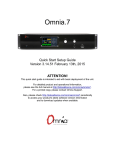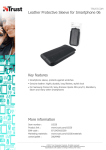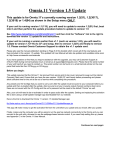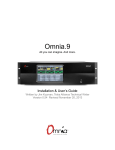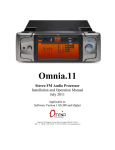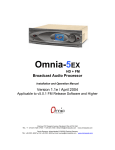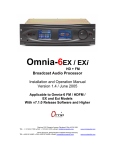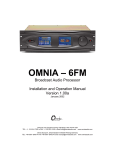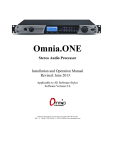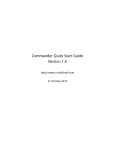Download Omnia.9 Quick Start Guide V3.00.16 8-28-14
Transcript
Omnia.9 All you can imagine. And more. Quick Start Setup Guide Version 3.00.16 Revised August 2014 Important Note: User Manual Addendum As of this publication, all Omnia.9 products are shipping with V3.00.16 software. This version brings with it many behind-the-scenes improvements that have allowed us not only to introduce new, more versatile system configurations but has also paved the way for some exciting future capabilities and features. At the forefront of these is the introduction of processing for AM! A User Manual Addendum covering the critical changes and differences in V3.00.16 is included at the end of the complete user manual (for V0.56.02) which remains the most current iteration of the full documentation. It is available for download from the Omnia website at http://omniaaudio.com. Please bear in mind that because some of the changes introduced in V3.00.16 affect the layout and structure of some menus and controls, there may be differences between the screenshots in the manual and what you see on the front panel of your Omnia.9 or in an NfRemote session. 2 Quick Start Setup Guide We know that you're probably in a hurry to get your new Omnia.9 installed and on the air. If you have technical expertise and previous knowledge of audio processor fundamentals, this Quick-Start Setup Guide will get you up and running as quickly as possible. It is important to remember that because Omnia.9 can be configured in many different ways, not all features and capabilities referenced in this guide or in the full product manual may be available in your particular unit. Therefore, some screenshots may differ slightly in appearance. We suggest having an assistant on hand when racking up Omnia.9 to help balance the unit during installation, and strongly recommend using all 4 rack screws for the best support. Although Omnia.9 is fan cooled, leaving an empty rack space directly above and below the unit is advisable. Physical Installation and Initial Configuration Connect AC power to both of the internal power supplies. There is no power switch. Failure to use both power supplies is interpreted by the unit as a failure in one of the supplies and will result in an audible alarm which can be silenced by pressing the small red button between the supplies. It is always possible for a supply to fail and so having redundant supplies does help protect you against losing power altogether in that event. However, it is far more likely that the unit will lose power because of an interruption in the circuit feeding the unit. Therefore, good engineering practice dictates that each supply should be fed from different sources. At minimum, we recommend that both should be a good quality UPS with adequate surge protection. Ideally, each would be fed from a completely different circuit for maximum redundancy. Next, connect the audio inputs as appropriate for your installation. Omnia.9 accepts balanced professional line-level analog audio via its Left and Right Inputs in the Main Analog I/O section of the rear panel, or AES/EBU digital audio on standard XLR connectors via its Main and AES Reference Inputs in the Main Digital I/O section of the rear panel and Aux Digital Input in the Aux Digital I/O section. A Word about AES Reference and Sample Rates: If you need to sync the Omnia.9 to an external reference, use the AES Reference Input to ensure that the externally generated reference will be used as the main clock for the Omnia.9. 3 However, Omnia.9’s main sample rate MUST be set to match the rate of the external reference at either 44.1 or 48kHz. These settings are found in the System Configuration portion of the System menu. For HD Radio, a sample rate of 44.1kHz is required. For DAB radio, a sample rate of 48kHz is required. Sample rate converters are present on both the Main Digital In and Aux Digital In connections, and accept any AES signal from 32 – 192kHz. From the Omnia.9 Home screen, select System, then I/O Options, then Input 1, 2 or 3. Each of Omnia.9’s three configurable internal inputs can be fed from any of the physical rear-panel inputs by using the dropdown menus for each Input Source as appropriate for your installation. In turn, each processing core is fed from one of the three internal input sources. The FM, HD-1, and Stream 1 cores are fed from Input 1. HD-2 and Stream 2 are fed from Input 2, while HD-3 and Stream 3 are fed from Input 3. The Studio core is fed from Input 1 by default but can be assigned its own separate input. Connect the audio outputs as appropriate for your installation. Omnia.9 supports balanced professional line-level analog audio outputs via its Left and Right Outputs in the Main Analog I/O section of the rear panel, two AES/EBU digital outputs on standard XLR connectors in the Main Digital I/O section, an additional digital output in the Aux Digital I/O section, and two composite MPX outputs in the Composite I/ O section. Return to the I/O Options menu, then select Main Outputs. Drop-down menus are provided to assign the outputs and set the levels of the Main FM Out 1, Main FM Out 2, Aux Out, and Analog Out jacks on the rear panel. Output audio choices include FM Pre-emphasized L/R, FM De-emphasized L/R, HD-1, HD-2, HD-3, Headphone Out, and Speaker Out. A complete explanation of these controls can be found in the System Menu section of the Home Menu. • Note: FM De-emphasized L/R is the least-recommended output option, especially for analog. Although is it possible in theory to have excellent peak modulation control even with external preemphasis, in practice not every stereo generator does pre-emphasis correctly. Certain stereo generators use phase-linear pre-emphasis in DSP, which is incorrect and causes roughly 20% overshoot (2dB loudness loss) when used with any audio processor. We recommend connecting the output of your stereo generator to one of Omnia.9's composite inputs, watching the Left De-mod waveform on the oscilloscope, and comparing it to L/R Output - Left Pre-emph. If you see high frequency peak overshoots, the stereo generator is faulty by design, and must either be replaced or have its pre-emphasis disabled, with Omnia.9's output set to FM Pre-emphasized. Omnia.9 is set up by default to provide a pre-emphasized MPX signal from the FM processing core. If you must use an external stereo generator, some additional configuration is required. From the Home menu, go to System, then System Configuration, then Processing Cores. Choose “MPX” if you only need the composite output of the stereo generator and have no need for pre-emphasized L/R audio. Choose “L/R” if you are you do not intend to use Omnia.9’s built-in stereo generator at all. Chose “MPX + L/R” if you plan to use the built-in stereo generator for your main output, but need an additional pre-emphasized L/R output to feed a secondary chain. Select “Apply Configuration” to put the changes in effect. This will cause the Omnia.9 to reinitialize, which will take your station off the air for a few seconds. From the Home menu, go to System, then I/O Options, then FM Options to select the Output Mode. Output levels and bandwidth can also be adjusted here. The FM diversity delay can be set by going to System, then I/O Options, then Diversity Delay. 4 • Note: Feeding the transmitter with L/R pre-emphasized output instead of the MPX output has several inherent performance disadvantages, including the loss of peaks beyond 91% (leaving room for the 19kHz pilot tone, as we will not know its phase) - a capability unique to the MPX clipper. RDS and Auto Pilot also become unavailable, though the L/R clipper does employ psychoacoustic distortion masking. From the Home menu, go to System, then I/O Options, then Source Adjustment. Use the Input Gain sliders to set the input levels. When driving the input with typical program material at normal operating levels, adjust the Input Gain while watching the Input meters in the Processing display window so that average levels keep the meters in the green. If the meters flash red, the input is being overdriven and levels to the Omnia.9 must be reduced. If necessary, it is also possible to invert the polarity of either or both channels with the Invert control. The Mode control allows several different channel configuration options. Return to the Home Menu, select FM, select Processing, then select Load Preset to choose one of the factory presets. "Rustonium" is the default preset and provides a well-balanced sound with competitive loudness, suitable for nearly any format. However, we suggest you audition all of the factory presets to get a feel for each of them. • Note: Omnia.9 contains a relay-bypass feature that allows unprocessed audio to pass directly through the unit to prevent complete loss of audio (dead air) any time the software is not active. This includes when the unit loses power, is in the start-up process, or must re-initialize its software after applying certain user-initiated configuration changes. Normally this is not an issue. However, in certain situations - for example, if you have a CD player connected to the analog inputs and an amplifier or speakers connected to the analog outputs - this means the input and output will be directly connected with no attenuation whatsoever, resulting in fried speakers (or eardrums) or an eviction notice following complaints from irritable neighbors. When engaged, the bypass relays hard wire the following inputs to outputs: Analog In > Analog Out Main Digital In > Main FM Out 1 Aux Digital In > Aux Out MPX In 1 > MPX Out 1 MPX In 2 > MPX Out 2 5 General Processing Advice Know Your Goals The first step to successful processing – and this applies to ANY processor, not just Omnia.9 - is defining your goals. Whatever those goals are, Omnia.9 is capable of getting you there. You may wish to maintain as much quality as possible while increasing loudness somewhat over your existing processor. You might want to create very consistent source-to-source spectral balance and develop a “signature sound” for your station. You may find yourself in a situation where you need to stay competitively loud on the dial at the expense of the best possible sound. Or you may have the luxury of aiming for a more open, cleaner sound that will draw and keep listeners for longer periods of time without having to worry about all-out loudness. In any case, it is best to start with a goal in mind and work toward it carefully and deliberately. Tweaking and Fiddling One big temptation when installing a new processor is fiddling with every available control, and there is no shortage of those in Omnia.9! There’s really no better way to find out what each control does, but experimentation and exploration are probably best done “on the bench” before you put your new acquisition on the air. That way, you’re free to tweak away without having to worry about jeopardizing your on-air sound or being unnecessarily timid about making adjustments because you don’t know what affect they will have. Another suggestion for getting to know your way around Omnia.9 is to find a factory preset that you like and then go exploring in the various menus to see how that sound was achieved. For example, let’s say you find a preset with a smooth, open sound which matches your general processing goal. As you explore, you might find some controls set as you would expect to deliver that sound, but you may also find some unexpected settings that make more creative use of Omnia.9’s controls. There is much to be learned by studying. Once you are comfortable with navigating through Omnia.9’s menus and have a good understanding of how its controls operate, you’re ready to take it for a test drive on the air. Choosing a Preset Regardless of whether you end up using a supplied preset “as-is” or make adjustments to customize your sound, you must start with one of the factory presets. We recommend you find one that most closely matches your goals and then make any modifications from there as needed. Most processors use radio format names to try and define their sound but then go on to explain there’s no reason a rock station shouldn’t try out the “Country” preset – which is very true. As a rule, Omnia.9 takes a deliberately different approach and most of its presets don’t give you any hint as to who should use them (or how) in the hopes that you’ll “step out of your box” a bit and explore. If your Country station sounds great on the air with settings that might mimic an “Urban” preset - with a slamming low end and a nice open mid-range – the last thing we want to do is make you second guess yourself because the preset name doesn’t match. 6 Making and Saving Changes Human nature is fickle; the human ear adapts and tires quickly; and Omnia.9 is powerful! With those things in mind, here are some recommended “Do’s” and “Don’ts” when making and saving changes to presets: • DO resist the temptation to constantly fiddle with every control right after you put Omnia.9 on the air. • DON’T make hasty, radical changes. • DON’T make adjustments to too many parameters at once – that makes it difficult to determine which of the adjustments is actually responsible for the changes (for better or worse) you’re hearing on the air. • DO look to the Band Mix and Parametric EQ sections first to achieve the spectral balance (aka “signature sound”) that you’re looking for. These are powerful adjustments, and a little EQ can go a long way. This is generally “safer” than making adjustments to the target, attack, and release rate controls as it is sometimes difficult to know how the different compression stages interact with one another on all material. • DO take breaks when adjusting your processing. Ears tire quickly, and if you stay at it too long, you’re almost sure to make changes influenced by fatigue. • DON’T turn your monitor speakers up too loud when making adjustments. High listening levels cause ears to tire even more quickly and mask both gain riding artifacts and distortion. Most listeners play the radio in the background, and problems tend to be more audible at comfortable listening levels. • DO make small adjustments, particularly to critical controls like Clipper and Limiter thresholds. • DO take the time to calibrate a set of high-quality reference monitors (a process described in detail in this manual) so that any changes you make aren’t skewed by colorations of the speakers or room. • DON’T rush the process. Use the “sleep-on-it” method when you’ve reached a point where you are mostly satisfied with the sound, and then re-evaluate it the next day. If it still sounds good, STOP. If it doesn’t, make a few adjustments and walk away for another day. • DO use the “Save As” method of naming and saving your custom presets rather than over-writing them. This will allow you to return to any point in your adjustments if you get too far “off track” and keep you from having to remember (or guess) what changes you’ve made along the way. Many Omnia.9 users have asked if they can make their own custom presets “from scratch.” All custom presets start life as a factory preset, but the most straightforward, neutral-sounding factory preset is “Reference Settings,” and as such provides the closest thing to a “blank canvas” possible for building your own preset from the ground up. 7 Troubleshooting FAQ In a perfect world, you will have read and followed the set up procedures in the handy Quick Start Setup Guide, all of the ins and outs pair up nicely, you found a preset or adjusted the audio to your liking, and you can enjoy a nice, relaxing lunch confident your station sounds better than ever. But every now and again, there are surprises or something doesn’t go quite as you expected the first time around (this IS radio, after all...) so we’ve assembled some frequently asked questions (and, as a bonus, some answers!) to the most common unexpected issues based upon conversations with many new users and the experience of our Omnia support team. The unit is totally dead. What should I check first? Let’s start with catastrophically bad first and get it out of the way: The unit won’t power up at all. Double-check that the unit is receiving AC line power to BOTH AC power connectors and the outlets into which they are plugged are live and working. (If there is power to only one supply, an alarm will sound, which can be temporarily silenced by pressing the small red button near the supplies.) Make sure all connections are secure at both ends of both cords. If all checks out so far, look at the front panel screen - is they any light on the display at all? If not, or if the screen appears scrambled, it may indicate a power supply problem. If you wish to examine the power supplies, be aware that they are of the switching type, and therefore require a load in order to start up and operate properly, and voltage measured when the supplies are not connected to the Omnia.9’s circuitry may not be correct. The unit boots up normally, but there is no audio output. What should I check? First, verify that there is audio appearing on both the input, output, and processing meters. If the metering looks normal, check to see if there is audio in the front panel headphone jack. If audio is present in the headphones, make sure your output connections are good. If there is no metering activity, go to Home> System>I/O Options>Input 1/2/3 and verify your input source is properly set. You should also verify there is audio present on the cable(s) feeding audio into Omnia.9. I have the unit in a quiet studio, and it sure is noisy. Omnia.9 utilizes four fans to provide cooling to the unit: One on the motherboard, one in the lid on the front left side of the unit, and one in each power supply, and they can be noisy. This is normal, as the unit was designed to be installed in a typical rack room or transmitter site where noise is not an issue. I have set the unit up on my network, but I cannot “ping” it. Why? This is normal, as network security for Omnia.9 is accomplished via a whitelist that is initially set up from the front panel. Navigate to Home>System>System Config>HTTP Access and add the IP address/addresses of computers that need to access Omnia.9’s HTTP server on Port 7380. Begin adding your IP addresses to the whitelist in the “IP 2” box, as “IP 1” is for use by the front panel touchscreen. 8 The HTTP server can be used to download the remote client software from the unit and for advanced scripting functions. Once downloaded, the remote client software itself does not require additional security access. The diversity delay is turned off, but there is still a full second of delay through the unit. Can it be reduced? No. The one second of delay is normal and integral to the the processing algorithms. In applications where analog FM and HD are broadcast, this should not be an issue as the analog audio must be delayed to match the digital audio. A dedicated low-latency Studio processing core is provided for talent monitoring. This can be used if Omnia.9 is located at the studio, or if a suitable low-delay return path is available from the transmitter site. Otherwise, we suggest using an older processor you may have available (or an Omnia.ONE Studio Pro) to drive talent headphones. I want to use the AES/EBU digital output to feed my linear digital STL at the studio. How do I activate this function? Navigate to Home>System>System Configuration>Processing Cores and set “FM” to “MPX+L/R”. It will ask you if you want to restart the unit. Ensuring that Omnia.9 is not actively on the air, follow through with the restart. Once re-started, navigate to Home>System>I/O Options>Main Outputs and set the AES/EBU output you are using to “FM Pre-emph L/R”. I found a preset I like, but I need more loudness. Some of the factory presets are “custom built for speed” right out of the box, and are already extracting as much loudness as possible from Omnia.9 without crossing the line where tighter dynamics and more clipping would simply degrade the audio. However, most presets have been created for a particular spectral mix or texture and have plenty of “room to grow” in terms of loudness without compromising overall quality. If you find you like one of these presets but just need more loudness, navigate to Home>FM>Processing>Clipper and advance the final clipper drive. Notice that it is possible to make 0.25dB adjustments, an indication that small adjustments are warranted here. We suggest advancing clipper drive 0.50dB at a time as you try to achieve more loudness. I found a preset I like, but I wish it were more open-sounding. See above, but in reverse! The clipper drive, more than any other single control, will have the greatest impact on the tradeoff between a more dynamic and open sound and all-out loudness. Reduce the clipper drive in small increments; we recommend 0.50dB at a time so that your station doesn’t become too quiet in your quest for openness. 9 Obtaining Service Before contacting Omnia Customer Support, please have the serial number of the unit (located on a small barcode sticker on the rear panel in this format - “0279xyyyy) and a description of the symptoms/problems ready for the technician. All units being returned for service MUST have a Return Authorization Number (RA) assigned to them first. Units shipped without an RA number will experience delays in service. Be sure to write the RA prominently on the box on or near the shipping label. Whenever possible, return Omnia.9 in its original shipping carton with original packing materials. This wil provide the best protection possible during shipping. Remember, damaged caused by improper packaging is not covered under warranty. Our shipping address is: Telos Alliance 1241 Superior Avenue East Cleveland, Ohio 44114 USA ATTN: (RA Number obtained from Omnia Customer Service) Support via the Web The Omnia website (http://omniaaudio.com) has a wide variety of information that may be useful for product support, applications information, software updates, and user manuals. Factory Support via Phone and E-mail Customer support personnel in the Cleveland, Ohio, USA office are available by phone or e-mail Monday through Friday 9:00am to 5:00pm Eastern Time by calling +1.216.241.7225 or sending an e-mail to “[email protected]”. After Hours Support After hours support is available 24/7 by telephone by calling +1.216.622.0247 or by sending an e-mail to “[email protected]”. If you are outside the United States and non-English speaking, please contact the dealer from whom you purchased your Omnia.9 first. 10 Omnia 1241 Superior Avenue East Cleveland, Ohio 44114 USA Tel: +1.216.241.7225 Fax: +1.216.241.4103 omniaaudio.com











